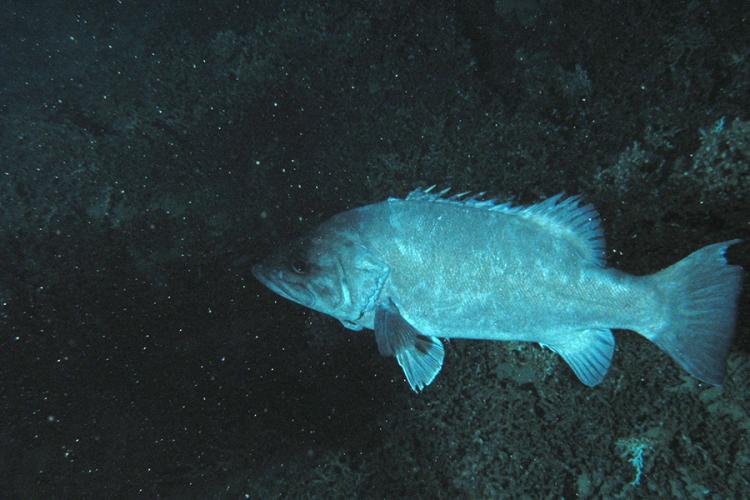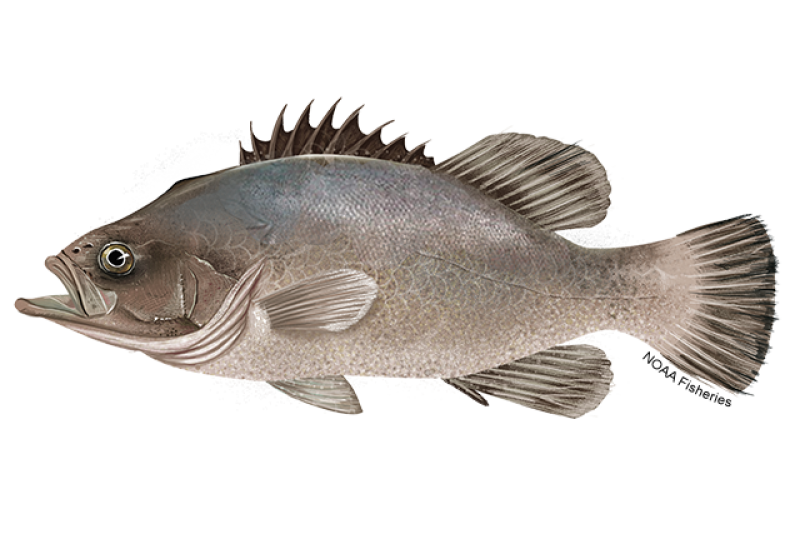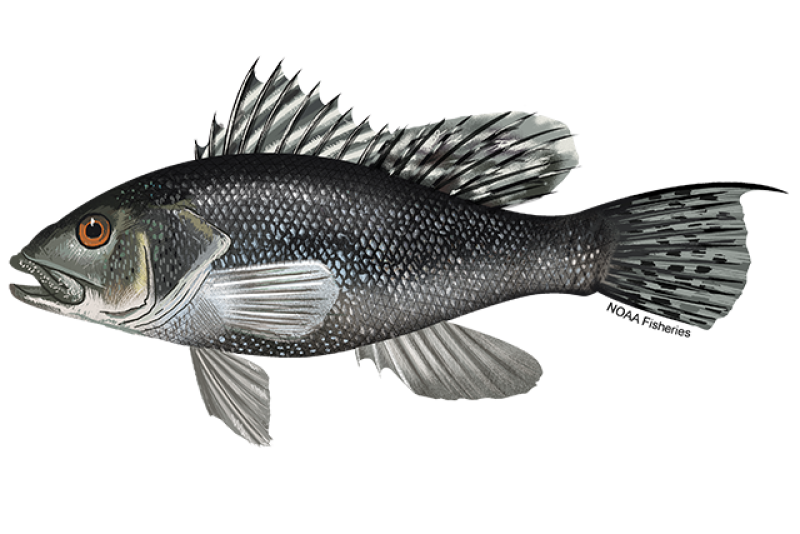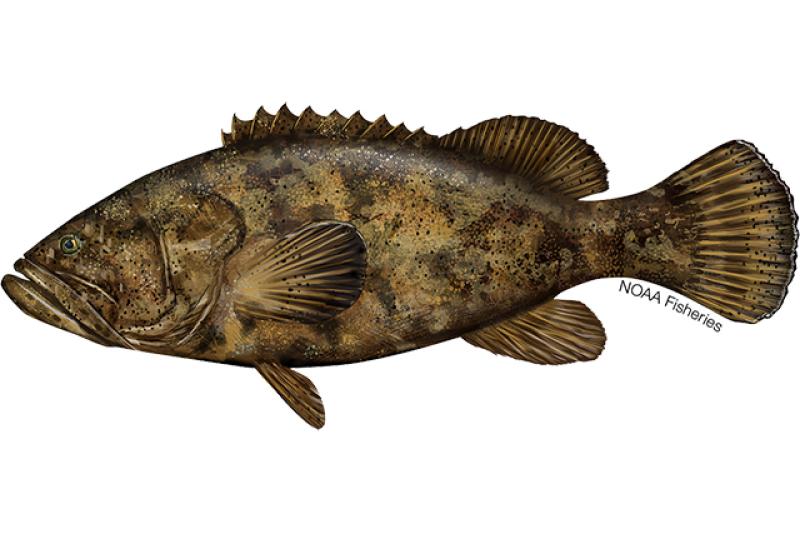 Wreckfish. Credit: NOAA Fisheries
Wreckfish. Credit: NOAA Fisheries
Wreckfish. Credit: NOAA Fisheries
About the Species
 Wreckfish. Credit: NOAA Fisheries
Wreckfish. Credit: NOAA Fisheries
Wreckfish. Credit: NOAA Fisheries
U.S. wild-caught wreckfish is a smart seafood choice because it is sustainably managed and responsibly harvested under U.S. regulations.

Population
The stock is not overfished.

Fishing Rate
Not subject to overfishing.

Habitat Impact
Fishing gear used to catch wreckfish has minimal impacts on habitat.

Bycatch
Bycatch is low because fishermen use a very selective method—bottom hook-and-line gear with hydraulic reels—to catch wreckfish.
Population Status
- According to the 2014 stock assessment wreckfish is not overfished. Summary stock assessment information can be found on Stock SMART. The stock is not subject to overfishing based on 2022 catch data.
Appearance
- Wreckfish are bluish gray on the back and paler with a silvery sheen on the belly. Fins are blackish brown. Juveniles have black blotches on their head and body.
- They have a big head with a big mouth and a rough, bony ridge across the upper part of the gill cover.
Biology
- Wreckfish are typically 40 to 60 pounds and 2.5 to 4 feet long, but can reach a maximum of 220 pounds and 6.5 feet.
- They have a long life span, with some living more than 70 years.
- They are able to reproduce at 8 years of age.
- From January through mid-April, wreckfish spawn multiple times in the Charleston Bump area. After eggs are fertilized externally, eggs and larvae are transported across the Atlantic Ocean to the coast of Europe, and return as adults to the southeastern coast of the United States.
- Wreckfish in the South Atlantic are large predators that lurk in caves and under overhangs on the Charleston Bump and come out to feed on fish and squid migrating during the day. They have no known predators.
Where They Live
Range
- Wreckfish are found in the western Atlantic Ocean from Grand Banks, Newfoundland, to La Plata River, Argentina.
Habitat
- Wreckfish live in water ranging in depth from 140 to 3,300 feet.
- Juvenile wreckfish are found in surface waters, often near floating debris.
- Adult wreckfish prefer steep, rocky ocean bottoms and deep reefs, which provide food and shelter. They’re often found near caves and overhangs.
Fishery Management
- NOAA Fisheries and the South Atlantic Fishery Management Council manage the wreckfish fishery.
- Managed under the Fishery Management Plan for the Snapper Grouper Fishery of the South Atlantic Region:
- A permit is required to fish for, land, or sell wreckfish.
- Bottom longlining is prohibited (only vertical hook-and-line may be used).
- Commercial fishery is closed during wreckfish spawning season (from mid-January through mid-April).
- The commercial fishery is managed under an individual transferable quota (ITQ, also known as catch shares) program. Each wreckfish fisherman owns a share of the quota and can choose to fish it anytime during the open season.
- 5 percent of the annual catch limit is allocated to recreational fishermen.
- Recreational fishing for wreckfish is allowed during July and August each year, and there is a bag limit per vessel.
Harvest
- The wreckfish fishery is small, with fewer than 10 vessels currently operating in the commercial sector. Commercial landings are confidential due to the limited number of participants.
- The total annual catch limit has remained over 400,000 pounds since 2015.
- Wreckfish fishermen are based in Charleston, South Carolina, northeast Florida, and the Florida Keys. They supply most of the wreckfish in the domestic market.
- Primary fishing grounds are the Charleston Bump, a deep-water bank located 80 to 100 miles southeast of Charleston, South Carolina.
- Commercial fishermen use heavy-duty hydraulic reels with 1/8-inch cable to harvest wreckfish. They attach heavy weights and multiple circle hooks baited with squid to the cable and fish just above the bottom.
Scientific Classification
- Wreckfish are found in the western Atlantic Ocean from Grand Banks, Newfoundland, to La Plata River, Argentina.
- Wreckfish live in water ranging in depth from 140 to 3,300 feet.
- Juvenile wreckfish are found in surface waters, often near floating debris.
- Adult wreckfish prefer steep, rocky ocean bottoms and deep reefs, which provide food and shelter. They’re often found near caves and overhangs.
Fishery Management
- NOAA Fisheries and the South Atlantic Fishery Management Council manage the wreckfish fishery.
- Managed under the Fishery Management Plan for the Snapper Grouper Fishery of the South Atlantic Region:
- A permit is required to fish for, land, or sell wreckfish.
- Bottom longlining is prohibited (only vertical hook-and-line may be used).
- Commercial fishery is closed during wreckfish spawning season (from mid-January through mid-April).
- The commercial fishery is managed under an individual transferable quota (ITQ, also known as catch shares) program. Each wreckfish fisherman owns a share of the quota and can choose to fish it anytime during the open season.
- 5 percent of the annual catch limit is allocated to recreational fishermen.
- Recreational fishing for wreckfish is allowed during July and August each year, and there is a bag limit per vessel.
Harvest
- The wreckfish fishery is small, with fewer than 10 vessels currently operating in the commercial sector. Commercial landings are confidential due to the limited number of participants.
- The total annual catch limit has remained over 400,000 pounds since 2015.
- Wreckfish fishermen are based in Charleston, South Carolina, northeast Florida, and the Florida Keys. They supply most of the wreckfish in the domestic market.
- Primary fishing grounds are the Charleston Bump, a deep-water bank located 80 to 100 miles southeast of Charleston, South Carolina.
- Commercial fishermen use heavy-duty hydraulic reels with 1/8-inch cable to harvest wreckfish. They attach heavy weights and multiple circle hooks baited with squid to the cable and fish just above the bottom.
Scientific Classification
| Kingdom | Animalia | Phylum | Chordata | Class | Actinopterygii | Order | Perciformes | Family | Polyprionidae | Genus | Polyprion | Species | americanus |
|---|
Last updated by NOAA Fisheries on 09/12/2025
Seafood Facts

Is Wreckfish Sustainable?
U.S. wild-caught wreckfish is a smart seafood choice because it is sustainably managed and responsibly harvested under U.S. regulations.
Availability
Fresh from mid-April through mid-January, but availability is sporadic because only a few fishermen harvest wreckfish.
Source
U.S. wild-caught, mostly from waters off South Carolina.
Taste
Wreckfish has a mild but distinct flavor similar to grouper.
Texture
The meat is firm and has a large flake. Its texture and consistency are similar to swordfish.
Color
White when raw and cooked.
Health Benefits
Wreckfish is a low-fat, high-protein source of B vitamins and minerals, including selenium.
Nutrition Facts
Servings: 1; Serving Weight: 100 g (raw); Calories: 97 ; Protein: 18.43 g ; Total Fat: 2 g; Total Saturated Fatty Acids: 0.511 g; Carbohydrate: 0 g; Total Sugars: 0 g; Total Dietary Fiber: 0 g; Cholesterol: 41 mg; Selenium: 36.5 mcg; Sodium: 68 mgMore Information
Wreckfish Recipes
Looking for some ways to add wreckfish into your rotation? Browse these recipes for easy oven-fried fish sticks, poached wreckfish, and more!

Last updated by NOAA Fisheries on 09/12/2025
Seafood News
 Thomas Piecuch flips floating oyster bags on his farm (Credit: Holy Ground Oyster Company).
Thomas Piecuch flips floating oyster bags on his farm (Credit: Holy Ground Oyster Company).
Celebrating Aquaculture Week: Farming from Tide to Table
 NOAA team members adjust a prototyped turtle excluder device (TED) before sending it to divers below for continued testing on the NOAA R/V Caretta. Credit: NOAA Fisheries (ESA Permit 20339)
NOAA team members adjust a prototyped turtle excluder device (TED) before sending it to divers below for continued testing on the NOAA R/V Caretta. Credit: NOAA Fisheries (ESA Permit 20339)
Small Modifications to Turtle Excluder Devices Have Big Impacts for Gulf Sea Turtles
 Pacific oysters travel down a sorting tumbler at Salty Lady Seafood Company in Juneau, Alaska. Credit: Salty Lady Seafood Company.
Pacific oysters travel down a sorting tumbler at Salty Lady Seafood Company in Juneau, Alaska. Credit: Salty Lady Seafood Company.
 Commercial fishing boats lined up in Sitka, Alaska. Credit: Shutterstock.
Commercial fishing boats lined up in Sitka, Alaska. Credit: Shutterstock.





